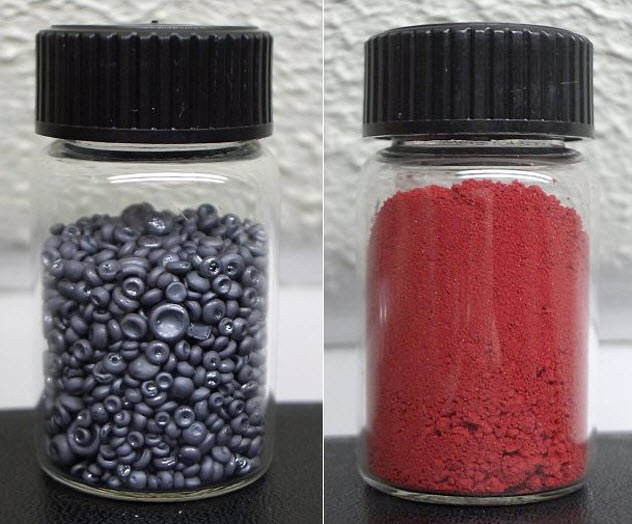 Creepy
Creepy  Creepy
Creepy  Movies and TV
Movies and TV 10 Movies That Get Elite Jobs Right, According to Experts
 Weird Stuff
Weird Stuff 10 Times Real Laws Were Based on Bizarre Hypotheticals
 Animals
Animals 10 Inspiring Tales of Horses Being Human
 Mysteries
Mysteries Top 10 Haunting Facts About the Ghost Ship MV Alta
 History
History 10 Surprising Stories About the Texas Rangers
 Humans
Humans 10 Philosophers Who Were Driven Mad by Their Own Theories
 Miscellaneous
Miscellaneous 10 Video-Game-Worthy Weapons and Armors from History
 Weird Stuff
Weird Stuff 10 Psychics Who Accurately Predicted Wartime Events
 The Arts
The Arts 10 Pieces of Art Inspired by a Broken Heart
 Creepy
Creepy 10 Death Superstitions That Will Give You the Creeps
 Movies and TV
Movies and TV 10 Movies That Get Elite Jobs Right, According to Experts
 Weird Stuff
Weird Stuff 10 Times Real Laws Were Based on Bizarre Hypotheticals
Who's Behind Listverse?

Jamie Frater
Head Editor
Jamie founded Listverse due to an insatiable desire to share fascinating, obscure, and bizarre facts. He has been a guest speaker on numerous national radio and television stations and is a five time published author.
More About Us Animals
Animals 10 Inspiring Tales of Horses Being Human
 Mysteries
Mysteries Top 10 Haunting Facts About the Ghost Ship MV Alta
 History
History 10 Surprising Stories About the Texas Rangers
 Humans
Humans 10 Philosophers Who Were Driven Mad by Their Own Theories
 Miscellaneous
Miscellaneous 10 Video-Game-Worthy Weapons and Armors from History
 Weird Stuff
Weird Stuff 10 Psychics Who Accurately Predicted Wartime Events
 The Arts
The Arts 10 Pieces of Art Inspired by a Broken Heart
10 Scientifically ‘Elemental’ Murders
Since Dmitri Mendeleev created his periodic table of elements in 1869, scientists have worked to identify the materials that make up the world around us. While many discoveries were made through fairly benign methods, there have been some horrifying deaths along the way.
Marie and Pierre Curie’s work with radioactive material killed the married couple. In fact, their notebooks are still so highly contaminated that researchers have chosen to lock them away.
There has always been a bit of excitement when a “new” element is discovered. In some cases, merchants and advertisers have unknowingly exposed thousands of people to dangerous chemicals, such as selling water laced with radium as a cure for ailments of the endocrine system.
Then there are those who took a different approach to testing and profiting from the elements.
10 Polonium
Polonium, a rare and extremely deadly element, was named by Marie Curie after her native country of Poland. Polonium also played a role in what appeared to be an assassination worthy of the best James Bond novels.
In 2006, former KGB member Alexander Litvinenko was rushed to a hospital in England after experiencing several days of diarrhea and vomiting as well as extreme pain. His condition deteriorated for three weeks, and then he died.
Investigators determined that Litvinenko had ingested polonium in a cup of tea. In fact, detectives discovered that they were able to track Andrey Lugovoi and Dmitry Kovtun, the suspected poisoners, throughout London by following the traces of polonium 210.
Litvinenko was fairly vocal in his belief that he had been targeted for assassination on the orders of Russian President Vladimir Putin. Although Britain requested Lugovoi’s extradition in 2007, Russia refuses to extradite its citizens for trial abroad. Lugovoi has since become a member of the Russian parliament, giving him immunity from prosecution.
9 Antimony

Antimony, a silvery-gray metal, is yet another rare and dangerous find. It can be used in its pure form to make semiconductors but is more likely to be used as a compound in anything from pottery to bullets.
In 1902, George Chapman gained notoriety for poisoning at least three of his mistresses. A native of Poland, Chapman (aka Severin Klosowski) had immigrated to England without his wife in the 1880s. According to some researchers, this timing also makes Chapman a possible suspect in the Jack the Ripper murders.
Nevertheless, his method of murder was fairly simple: Find a young lady who was willing to pretend that they were married and then poison her with antimony when he wanted to move on. His first known victim, Mary Spink, became ill and died in December 1897. Bessie Taylor experienced a similar fate in February 1899.
Maud Marsh was Chapman’s next victim. At 18, she began working at his latest pub and became upset when it appeared that her “husband” was interested in another barmaid. Although Maud’s family had insisted that she go to the hospital as soon as she displayed signs of illness, Chapman had administered enough poison to kill her by October 1902.
During the investigation, the bodies of Mary and Bessie were also examined. Antimony acts as a preservative, and their bodies had barely decayed at all. Enough evidence was found to have Chapman hanged on April 7, 1903.
8 Phosphorus

Phosphorus, the “element of light,” is readily available to the general public when using ready-strike matches. The red stripe on the side of matchboxes contains red phosphorus. It is converted to the more volatile white phosphorus when the match is struck against the red stripe on the box.
In its phosphate form, this element is a crucial part of our DNA. But phosphorus can also be used as a deadly weapon. It can be tricky, though, because phosphorus glows in the dark. In 1864, a report from Berlin described an attempted poisoning in which a woman placed phosphorus in her husband’s soup. But his friends noticed that the liquid glowed as he stirred it.
In 1899, Mary Ann Ansell sent her sister, Caroline, a cake laced with phosphorus to secure an insurance settlement. From 1955 to 1957, Mary Elizabeth Wilson (aka the merry widow of Windy Nook) used pesticide containing phosphorus to rid herself of some troublesome “pests,” including three husbands and a lover.
7 Thallium
Thallium, a soft element that can be cut with a knife, turns blue-green when exposed to oxygen. Discovered in 1861, this element is usually found as a mineral and can be extracted from iron pyrite. Once used in rodenticides, thallium was banned in the US in 1972 due to its potentially harmful effects on humans.
Thallium is sometimes called an “inheritance powder” because it has been used so often in murders throughout the ages. In 1988, Peggy Carr of Alturas, Florida, began to experience nausea, hair loss, and extreme pain in her arms and legs. After lapsing into a months-long coma, she died in March 1989.
When doctors investigated, they discovered that Peggy and four family members had ingested thallium. A neighbor named George Trepal had complained on multiple occasions about the family’s loud music and activities. He soon became the prime suspect.
Trepal was a member of Mensa and believed that he was superior to the Carr family. According to investigators, that was why Trepal used his skills in chemistry to poison bottles of Coca-Cola, a favorite drink of the Carr family.
6 Sodium
Sodium (aka element 11) is part of everyday life. This element is usually encountered as a compound, which is often a safer formulation because pure sodium is extremely reactive in the presence of water.
The human body requires a certain amount of sodium to function properly, especially with respect to blood pressure levels. This is even more important in children. Unfortunately, some mothers appear to view sodium as the perfect weapon.
In 2005, Petrina Stocker was convicted of manslaughter in the death of her son, David. The nine-year-old had been admitted to Great Ormond Street Hospital with a mysterious range of symptoms, and nurses grew suspicious that Petrina was somehow making his condition worse.
A few weeks before he died, hospital staff decided that David should not be left alone with his mother. However, Petrina gained access to a fridge near the ward and added 18 teaspoons of salt to a bag of nutritional feed that was later given to David via an intravenous drip.
He immediately fell into a coma and died two days later. It subsequently emerged that Petrina had a history of faking medical problems and had once poured acid over her arms and face in an attempt to pass herself off as a leukemia survivor.
5 Selenium

Selenium, a rare element named after the Moon, appears red, metallic gray, or black depending on its form. We all have trace amounts of selenium in our bodies, although too much is poisonous. Selenium is also used regularly in electronics due to its photoconductive properties.
In 1988, Richard Overton chose selenium as a method of poisoning. However, his first poisoning occurred when he spiked his ex-wife Dorothy Boyer’s coffee with Drano and prescription drugs in the early 1970s.
Boyer had been given the house following the couple’s divorce, and Overton did not feel that this was fair. Although Overton admitted the poisoning to authorities, Boyer refused to press charges.
With another wife, Overton began with selenium and then added cyanide to the mix. Although Janet Overton knew that her 19-year marriage was in trouble, she saw no reason to get a divorce. So Richard Overton freed himself by poisoning her to death.
When Boyer saw the notice of Janet’s death, she notified local police of her previous experience. The case garnered a lot of attention as the Overtons were well-known in their community. The Lifetime channel even produced a movie called Lethal Vows based on the case.
4 Mercury

Although mercury is useful in conducting electricity, it is also extremely toxic to humans. Its symbol, Hg, stands for hydrargyrum (“liquid silver”).
The phrase “mad as a hatter” refers to the bizarre behaviors of those who were once exposed to this element while preparing materials for hats. Today, we have to be careful when eating fish because the levels of methylmercury in our oceans are rising from pollution. Although most contact with mercury occurs through accidents or curiosity, there are also cases of intentional harm.
In 1897, Roland Molineux resigned his membership at the exclusive Knickerbocker Club in New York after repeated incidents with other members. Unable to get over his ouster, Molineux attempted to poison those with whom he was angry by sending them packages of patent medicines with a secret ingredient: mercury cyanide.
In October 1898, the death of his first victim, Henry Barnet, was initially believed to have been caused by diphtheria. Molineux’s second poisoning attempt went spectacularly wrong when his intended victim, Harry Cornish, prepared a dose of the poisoned medicine for his cousin Katherine Adams because she was complaining of a headache.
Cornish tried some of the preparation after Adams complained of the taste. Within 30 minutes, Adams was dead and Cornish was in severe pain.
People v. Molineux is considered a landmark case because an appeals court decided that the evidence regarding Barnet’s death should not have been allowed during the trial. The court’s reasoning was that Molineux had been denied the presumption of innocence that is guaranteed by US law. Molineux was acquitted after a retrial.
3 Potassium
Potassium is an essential but volatile element that is needed by the human body to regulate muscular contractions. Although most of us do not get enough potassium in our diets, it is important to note that potassium in its pure form is extremely reactive. Therefore, this element is usually used in one of its compound forms such as saltpeter or potash.
Potassium chloride is considered a double-edged sword. Small doses can be used to treat deficiencies, but large doses can stop the heart. For this reason, it has been used in lethal injections, both legal and illegal.
There are a number of suspected “mercy killings” by doctors or nurses who wished to help their patients escape the pain of possibly terminal diseases. Unfortunately, there are also people who have randomly killed those in their care simply because they could.
Orville Lynn Majors was convicted of killing six patients while working at a hospital in Indiana. However, he is suspected of killing over 100 patients between 1993 and 1995.
Daniela Poggiali may have been just as prolific. Investigations into her actions between April 2013 and April 2014 have possibly linked her to as many as 96 deaths.
Both Majors and Poggiali are reported to have disliked patients and coworkers around them. In Poggiali’s case, she is known to have taken a selfie over the body of her last suspected victim.
2 Carbon

Carbon exists throughout our known universe. We breathe it out, and trees breathe it in. Scientists use carbon 14 to date organic material. One of the most abundant elements, carbon has a gift for linking and creating compounds. It is essential to life as we know it.
Most deaths by carbon monoxide are accidents caused by a buildup of gas in an improperly vented area. Carbon monoxide is also used to commit suicide, usually in the form of car exhaust.
A Japanese woman named Kanae Kijima used carbon monoxide poisoning to hide her habit of talking lonely men into giving her money and expensive gifts before killing them. Kijima got to know the men through online dating sites before using their money to buy luxuries for herself.
Once she had what she wanted, Kijima used a sleeping pill to knock the man out before lighting charcoal briquettes and leaving behind his “suicide” note. Her third victim, Yoshiyuki Oide, had transferred five million yen to Kijima, his supposed fiancee, before dying in a locked car with no keys in the ignition.
1 Arsenic

In its purest form, arsenic is a brittle, gray, metallic crystal that crumbles to the touch. We often think of arsenic as a poison due to its usage throughout history as an “inheritance powder.” In truth, arsenic has many uses—from hair removal to the making of linoleum. Oddly enough, heated arsenic smells of garlic.
Although chemist James Marsh developed a test to easily detect arsenic in 1836, regulation of this element did not happen for some time. So arsenic-related murders continued to be fairly common because this element was readily available in medicines and pesticides.
Judy Buenoano found arsenic to be a helpful tool in making money. Between 1971 and 1980, she collected life insurance settlements on her husband, son, and boyfriend.
In 1982, Buenoano had begun poisoning her latest lover, John Gentry. Then she decided to take more drastic measures and attempted to blow up his car instead. At that point, investigators took an active interest in the previous deaths and discovered arsenic in the bodies of her previous victims. Buenoano was executed in Florida in 1998.
Sarah Jennings is a freelance writer and bibliophile who spends way too much time reading lists.








